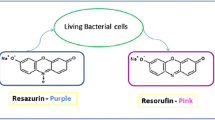Abstract
Rhamnolipids, produced by Pseudomonas aeruginosa, represent an important group of biosurfactants having various industrial, environmental, and medical applications. Current methods for rhamnolipid quantification involve the use of strong hazardous acids/chemicals, indirect measurement of the concentration of sugar moiety, or require the availability of expensive equipment (HPLC-MS). A safer, easier method that measures the whole rhamnolipid molecules would significantly enhance strain selection, metabolic engineering, and process development for economical rhamnolipid production. A semi-quantitative method was reported earlier to differentiate between the rhamnolipid-producing and non-producing strains using agar plates containing methylene blue and cetyl trimethylammonium bromide (CTAB). In this study, a rapid and simple method for rhamnolipid analysis was developed by systematically investigating the complexation of rhamnolipids and methylene blue, with and without the presence of CTAB. The method relies on measuring the absorbance (at 638 nm) of the rhamnolipid−methylene blue complex that partitions into the chloroform phase. With P. aeruginosa fermentation samples, the applicability of this method was verified by comparison of the analysis results with those obtained from the commonly used anthrone reaction technique.





Similar content being viewed by others
References
Benincasa M (2007) Rhamnolipid produced from agroindustrial wastes enhances hydrocarbon biodegradation in contaminated soil. Curr. Microbiol 54(6):445–449
Chandrasekaran EV, BeMiller JN (1980) Constituent analysis of glycosaminoglycans. In: Whistler RL, BeMiller JN (eds) Methods in carbohydrate chemistry, vol 8. Academic Press, New York, pp 89–96
Chayabutra C, Ju L-K (2000) Degradation of n-hexadecane and its metabolites by Pseudomonas aeruginosa under microaerobic and anaerobic denitrifying conditions. Appl Environ Microbiol 66(2):493–498
Chayabutra C, Ju L-K (2001) Polyhydroxyalkanoic acids and rhamnolipids are synthesized sequentially in hexadecane fermentation by Pseudomonas aeruginosa ATCC 10145. Biotechnol Progr 17(3):419–423
Chayabutra C, Wu J, Ju L-K (2001) Rhamnolipid production by Pseudomonas aeruginosa under denitrification: effects of limiting nutrients and carbon substrates. Biotechnol Bioeng 72(1):25–33
Desai JD, Banat IM (1997) Microbial production of surfactants and their commercial potential. Microbiol Mol Biol Rev 61(1):47–64
Eaton AD, Clesceri LS, Greenberg AE (1995) Standard methods for the examination of water and wastewater. American Public Health Association, Washington, DC
Gunther NWIV, Nunez A, Fett W, Solaiman DKY (2005) Production of rhamnolipids by Pseudomonas chlororaphis, a nonpathogenic bacterium. Appl Environ Microbiol 71(5):2288–2293
Heyd M, Kohnert A, Tan TH, Nusser M, Kirschhoefer F, Brenner-Weiss G, Franzreb M, Berensmeier S (2008) Development and trends of biosurfactant analysis and purification using rhamnolipids as an example. Analytical and Bioanalytical Chemistry 391(5):1579–1590
Hodge JE, Hofreiter BT (1962) Determination of reducing sugars and carbo- hydrates. In: Whistler RL, Wolfrom ML (eds) Methods in carbohydrate chemistry, vol 1. Academic, New York, pp 380–394
Jurado E, Fernandez-Serrano M, Nunez-Olea J, Luzon G, Lechuga M (2006) Simplified spectrophotometric method using methylene blue for determining anionic surfactants: Applications to the study of primary biodegradation in aerobic screening tests. Chemosphere 65(2):278–285
Koga M, Yamamichi Y, Nomoto Y, Irie M, Tanimura T, Yoshinaga T (1999) Rapid determination of anionic surfactants by improved spectrophotometric method using methylene blue. Anal Sci 15(6):563–568
Mercade ME, Manresa MA (1994) The use of agroindustrial byproducts for biosurfactant production. J Am Oil Chem Soc 71(1):61–4
Siegmund I, Wagner F (1991) New method for detecting rhamnolipids excreted by Pseudomonas species during growth on mineral agar. Biotechnol Tech 5(4):265–8
Soberon-Chavez G, Lepine F, Deziel E (2005) Production of rhamnolipids by Pseudomonas aeruginosa. Appl Microbiol Biotechnol 68(6):718–725
Turney ME, Cannell DW (1965) Alkaline methylene blue method for determination of anionic surfactants and for amine oxides in detergents. J Am Oil Chem Soc 42(6):544–6
Wang Q, Fang X, Bai B, Liang X, Shuler PJ, Goddard WA, Tang Y (2007) Engineering bacteria for production of rhamnolipid as an agent for enhanced oil recovery. Biotechnol Bioeng 98(4):842–853
Wild M, Caro AD, Hernandez AL, Miller RM, Soberon-Chavez G (1997) Selection and partial characterization of a Pseudomonas aeruginosa mono-rhamnolipid deficient mutant. FEMS Microbiol Lett 153(2):279–285
Zhang Q (2007) Collection of Trichoderma reesei cellulase by foaming. The University of Akron, Akron, OH
Zhu L, Zhang M (2008) Effect of rhamnolipids on the uptake of PAHs by ryegrass. Environ Pollut (Amsterdam, Netherlands) 156(1):46–52
Acknowledgments
The study was supported by the U.S. Department of Transportation, Office of the Secretary, Grant No. DTOS59-07-G-00050. The authors also thank Dr. Tsung Min Kuo (USDA-ARS-NCAUR, Peoria, IL) for providing the P. aeruginosa strain isolated from the soil samples at a biodiesel plant, and Ms. Jennifer Lilly and Mr. Aaron Cook for their assistance in carrying out the experimental procedures.
Author information
Authors and Affiliations
Corresponding author
Rights and permissions
About this article
Cite this article
Pinzon, N.M., Ju, LK. Analysis of rhamnolipid biosurfactants by methylene blue complexation. Appl Microbiol Biotechnol 82, 975–981 (2009). https://doi.org/10.1007/s00253-009-1896-9
Received:
Revised:
Accepted:
Published:
Issue Date:
DOI: https://doi.org/10.1007/s00253-009-1896-9




